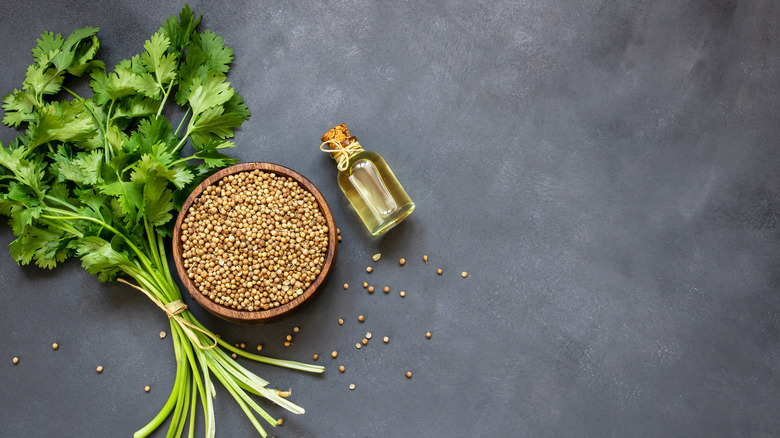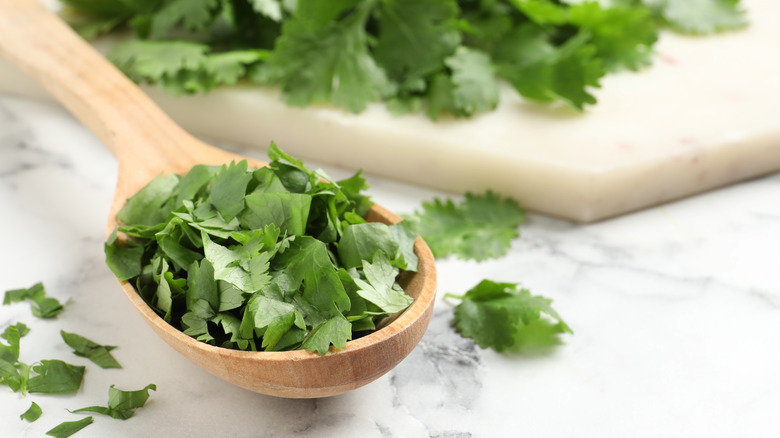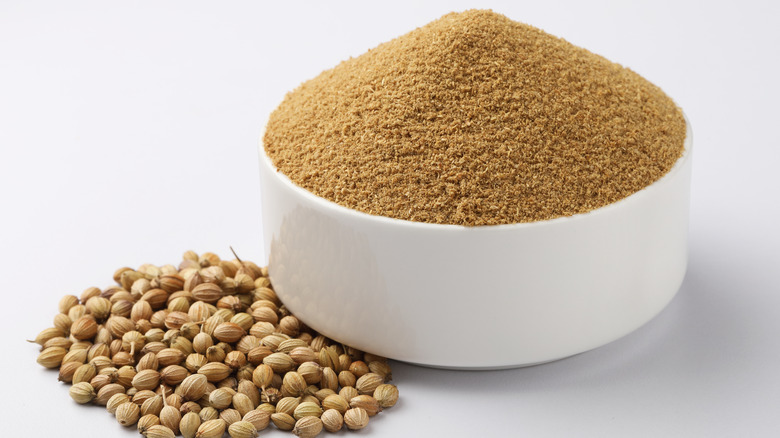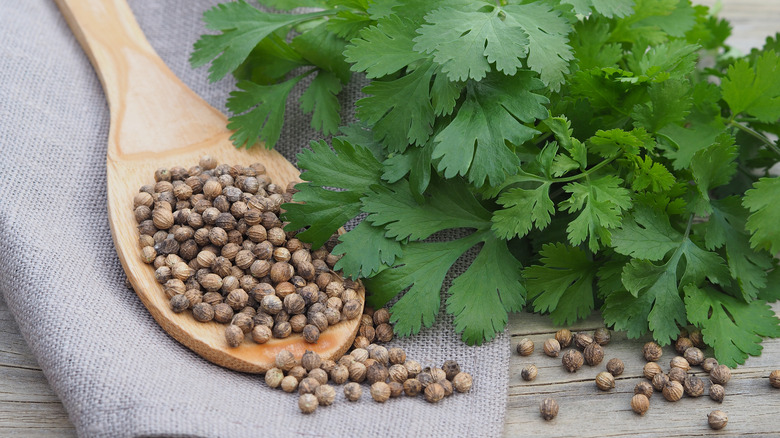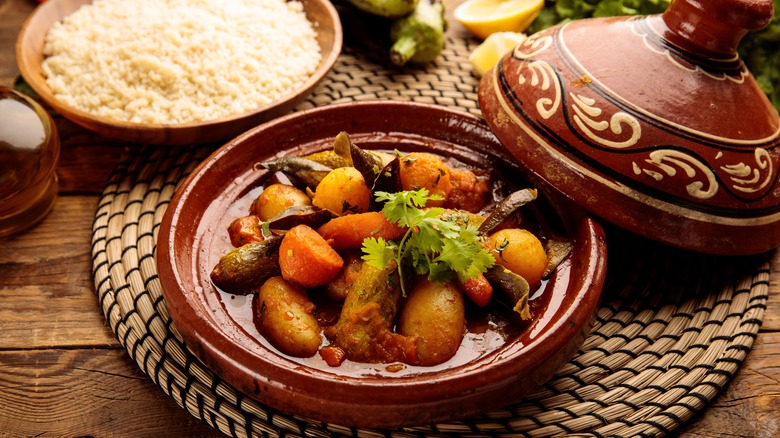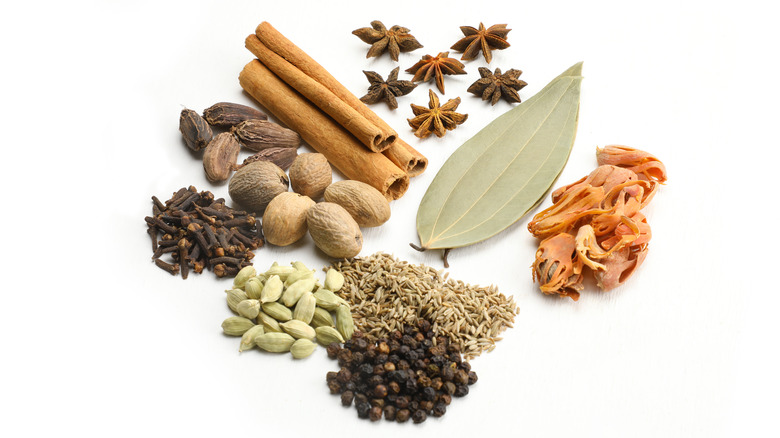Cilantro Vs. Coriander: What's The Difference?
Cilantro is that fresh, citrusy herb that makes up a distinct flavor component in a variety of Southeast Asian dishes, according to On the Gas. Coriander is another word for the same herb, mostly used by the Brits or Aussies—or so you may think. So what's really the big difference? Why the two different names? The truth is, cilantro and coriander are completely different parts of the same plant, according to Healthline.
The two herbs are often mistaken for each other due to a difference in word usage between America, the U.K. and Australia. In the U.K. and Australia, people mostly refer to that fragrant green herb as coriander, which comes from the scientific term for the plant it comes from Coriandrum Sativum (via Colorado Integrated Food Safety Center of Excellence). Americans refer to that same herb as cilantro because it is the Spanish word for "coriander leaves." So what is coriander in the States?
What is cilantro?
First, let's understand what cilantro is. Cilantro is the leaf and stalk of the Coriandrum Sativum that you add to guacamole, pad thai, pho—you name it (via Pure Wow). Although cilantro is a beloved flavoring agent in many cuisines around the globe, not everyone is fond of it. In fact, some people claim to have a specific gene that makes it taste like soap—which was found in a study to be a particular olfactory gene that makes the smell and taste of cilantro quite unbearable for people sharing this gene.
Cilantro is usually added to dishes as a garnish, so that its freshness lightens up anything savory, sweet, or smoky, in the same way that pepper or lemon zest does. For this reason, cilantro is also called Chinese parsley on Britannica, because it occupies the same place that parsley does in European cuisine—an herbaceous and fragrant garnish. Like parsley, cilantro has a particularly fresh taste that is added to a dish when it is ready to be served. Not to mention, upon a quick glance, these two herbs look incredibly similar and can even be mistaken for one another.
What is coriander?
In the U.K. and Australia, people refer to cilantro as coriander. However, in the States, coriander refers to the seeds of the same plant. Coriander is the seed from which the cilantro grows, and it tastes nothing like cilantro. These seeds are similar to white peppercorns in appearance and size and have a beige tint to them. They are usually sold in either their whole, dried seed form or ground up, per Healthline. Brits and Aussies call them coriander seeds to distinguish them from the leafy parts they call coriander, via Pure Wow.
Coriander can be less offensive to those who cannot handle cilantro, but it all comes down to personal taste. Coriander's flavor profile is somewhere in between that of cumin, fennel seeds, and black pepper, which makes it earthy and slightly bitter, according to Yum of China. Coriander seeds are often used in Indian cuisine as a part of garam masala, or they're used whole in broths to add a subtle pepper or anise seed flavor.
Nutritional differences
Although both cilantro and coriander both stem from the Coriandrum Sativum, they have very different nutritional profiles. While cilantro leaves offer tons of vitamins, such as Vitamin A, C, K, they lack minerals (via Healthline). Like many leafy greens or fresh herbs, cilantro is mostly made up of water, coming up to 92.2% water content, as shown in this scientific study on leafy greens. On the other hand, coriander seeds have little to no water content and are mostly made up of minerals like manganese, magnesium, calcium, copper, phosphorous, and selenium, per Healthline. Coriander seeds also have much more dietary fiber than cilantro does, up to 16 times more.
Both cilantro and coriander have their nutritional benefits. Cilantro is touted as a natural treatment for a variety of diseases or sicknesses, as reported by the Colorado Integrated Food Safety Center of Excellence. While coriander was found to have decreased blood pressure in an animal study. According to The Herb Information Center, both cilantro and coriander have antioxidant effects on the body, and can even lower the risk of heart disease, although further research on these effects in humans is required.
Best ways to use each
As mentioned earlier, cilantro and coriander have different purposes in the kitchen. Cilantro is most often used in Southeast Asian and Mexican cuisine as a refreshing garnish for soups, meats, and dips. The Herb Information Center notes that coriander is frequently found in Indian, African, and Middle Eastern cuisines, as a semi-fragrant spice that adds complexity to a soup or porridge.
It is best to use cilantro in its raw, fresh state—since the herb deteriorates in heat, which diminishes its flavor and scent significantly. Cooking down cilantro gets rid of its desired aroma and finishing pop of color. There are a number of ways to incorporate cilantro in your food, outside of its traditional place in banh mis, tacos, and Thai food. Cilantro pairs wonderfully with acids, like lemon or lime juice, over barbecues, and in clear broths, as long as these dishes do not contain these ingredients that clash with cilantro.
Since coriander is more spicy and nutty than it is zesty, it is a staple in spice blends and stews like garam masala and North African tagine. Thanks to its subtle, earthy flavor profile, coriander can be used in so many different foods, from a rack of lamb to a loaf of fresh bread. While cilantro is best used in its fresh, raw state, coriander actually becomes more fragrant when toasted. Whether it comes ground or whole, it's a good idea to have some coriander in your pantry.
Can I substitute cilantro for coriander, or vice versa?
Well, substituting cilantro for coriander would be the equivalent of using cumin for parsley, so no. You should not use these items interchangeably unless you want to alter the entire dish. Cilantro is a robust, yet refreshing herb, while coriander is a subtle spice that shares the slightly bitter spice of fennel and peppercorns.
If you're in a bunch for either of these ingredients, there are better substitutes for each. But before you go on with cooking, you should figure out whether or not the recipe you're following is referring to the right coriander (there is a high chance of it being something different if the recipe was written by someone from across the pond). Once you have that sorted, find the appropriate substitutes. Cilantro is a bit hard to replace since it has a characteristically citrusy, floral scent, but peppery herbs like parsley and basil can do the trick. Coriander is a bit easier to substitute since it is a generally mellow spice. Pure Wow suggests using cumin, fennel seeds, anise seeds, or even nutmeg as a replacement. You can even use curry powder or garam masala since both usually contain ground coriander.
